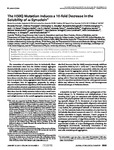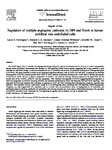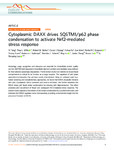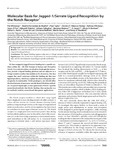The H50Q Mutation Induces a 10-fold Decrease in the Solubility of α-Synuclein
| dc.contributor.author | Porcari, R | |
| dc.contributor.author | Proukakis, C | |
| dc.contributor.author | Waudby, CA | |
| dc.contributor.author | Bolognesi, B | |
| dc.contributor.author | Mangione, PP | |
| dc.contributor.author | Paton, JFS | |
| dc.contributor.author | Mullin, Stephen | |
| dc.contributor.author | Cabrita, LD | |
| dc.contributor.author | Penco, A | |
| dc.contributor.author | Relini, A | |
| dc.contributor.author | Verona, G | |
| dc.contributor.author | Vendruscolo, M | |
| dc.contributor.author | Stoppini, M | |
| dc.contributor.author | Tartaglia, GG | |
| dc.contributor.author | Camilloni, C | |
| dc.contributor.author | Christodoulou, J | |
| dc.contributor.author | Schapira, AHV | |
| dc.contributor.author | Bellotti, V | |
| dc.date.accessioned | 2021-01-12T15:23:32Z | |
| dc.date.available | 2021-01-12T15:23:32Z | |
| dc.date.issued | 2015-01 | |
| dc.identifier.issn | 0021-9258 | |
| dc.identifier.issn | 1083-351X | |
| dc.identifier.uri | http://hdl.handle.net/10026.1/16798 | |
| dc.description.abstract |
The conversion of α-synuclein from its intrinsically disordered monomeric state into the fibrillar cross-β aggregates characteristically present in Lewy bodies is largely unknown. The investigation of α-synuclein variants causative of familial forms of Parkinson disease can provide unique insights into the conditions that promote or inhibit aggregate formation. It has been shown recently that a newly identified pathogenic mutation of α-synuclein, H50Q, aggregates faster than the wild-type. We investigate here its aggregation propensity by using a sequence-based prediction algorithm, NMR chemical shift analysis of secondary structure populations in the monomeric state, and determination of thermodynamic stability of the fibrils. Our data show that the H50Q mutation induces only a small increment in polyproline II structure around the site of the mutation and a slight increase in the overall aggregation propensity. We also find, however, that the H50Q mutation strongly stabilizes α-synuclein fibrils by 5.0 ± 1.0 kJ mol(-1), thus increasing the supersaturation of monomeric α-synuclein within the cell, and strongly favors its aggregation process. We further show that wild-type α-synuclein can decelerate the aggregation kinetics of the H50Q variant in a dose-dependent manner when coaggregating with it. These last findings suggest that the precise balance of α-synuclein synthesized from the wild-type and mutant alleles may influence the natural history and heterogeneous clinical phenotype of Parkinson disease. | |
| dc.format.extent | 2395-2404 | |
| dc.format.medium | Print-Electronic | |
| dc.language | en | |
| dc.language.iso | eng | |
| dc.publisher | Elsevier BV | |
| dc.rights | Attribution-NonCommercial 4.0 International | |
| dc.rights | Attribution-NonCommercial 4.0 International | |
| dc.rights | Attribution-NonCommercial 4.0 International | |
| dc.rights | Attribution-NonCommercial 4.0 International | |
| dc.rights | Attribution-NonCommercial 4.0 International | |
| dc.rights | Attribution-NonCommercial 4.0 International | |
| dc.rights | Attribution-NonCommercial 4.0 International | |
| dc.rights.uri | http://creativecommons.org/licenses/by-nc/4.0/ | |
| dc.rights.uri | http://creativecommons.org/licenses/by-nc/4.0/ | |
| dc.rights.uri | http://creativecommons.org/licenses/by-nc/4.0/ | |
| dc.rights.uri | http://creativecommons.org/licenses/by-nc/4.0/ | |
| dc.rights.uri | http://creativecommons.org/licenses/by-nc/4.0/ | |
| dc.rights.uri | http://creativecommons.org/licenses/by-nc/4.0/ | |
| dc.rights.uri | http://creativecommons.org/licenses/by-nc/4.0/ | |
| dc.subject | Aggregation Propensity | |
| dc.subject | Amyloid | |
| dc.subject | Fibril | |
| dc.subject | Fibrils Thermodynamic Stability | |
| dc.subject | Parkinson Disease | |
| dc.subject | Polyproline II Structure | |
| dc.subject | Protein Aggregation | |
| dc.subject | alpha-Synuclein (a-synuclein) | |
| dc.subject | Amyloid | |
| dc.subject | Binding Sites | |
| dc.subject | Humans | |
| dc.subject | Lewy Bodies | |
| dc.subject | Magnetic Resonance Spectroscopy | |
| dc.subject | Microscopy, Atomic Force | |
| dc.subject | Mutation | |
| dc.subject | Parkinson Disease | |
| dc.subject | Peptides | |
| dc.subject | Phenotype | |
| dc.subject | Protein Binding | |
| dc.subject | Protein Isoforms | |
| dc.subject | Protein Structure, Secondary | |
| dc.subject | Recombinant Proteins | |
| dc.subject | Solubility | |
| dc.subject | Thermodynamics | |
| dc.subject | alpha-Synuclein | |
| dc.title | The H50Q Mutation Induces a 10-fold Decrease in the Solubility of α-Synuclein | |
| dc.type | journal-article | |
| dc.type | Journal Article | |
| dc.type | Research Support, Non-U.S. Gov't | |
| plymouth.author-url | https://www.webofscience.com/api/gateway?GWVersion=2&SrcApp=PARTNER_APP&SrcAuth=LinksAMR&KeyUT=WOS:000348588000042&DestLinkType=FullRecord&DestApp=ALL_WOS&UsrCustomerID=11bb513d99f797142bcfeffcc58ea008 | |
| plymouth.issue | 4 | |
| plymouth.volume | 290 | |
| plymouth.publication-status | Published | |
| plymouth.journal | Journal of Biological Chemistry | |
| dc.identifier.doi | 10.1074/jbc.m114.610527 | |
| plymouth.organisational-group | /Plymouth | |
| plymouth.organisational-group | /Plymouth/Faculty of Health | |
| plymouth.organisational-group | /Plymouth/Faculty of Health/Peninsula Medical School | |
| plymouth.organisational-group | /Plymouth/REF 2021 Researchers by UoA | |
| plymouth.organisational-group | /Plymouth/REF 2021 Researchers by UoA/UoA01 Clinical Medicine | |
| plymouth.organisational-group | /Plymouth/Research Groups | |
| plymouth.organisational-group | /Plymouth/Research Groups/FoH - Applied Parkinson's Research | |
| plymouth.organisational-group | /Plymouth/Research Groups/FoH - Community and Primary Care | |
| plymouth.organisational-group | /Plymouth/Users by role | |
| plymouth.organisational-group | /Plymouth/Users by role/Academics | |
| plymouth.organisational-group | /Plymouth/Users by role/Researchers in ResearchFish submission | |
| dc.publisher.place | United States | |
| dc.identifier.eissn | 1083-351X | |
| dc.rights.embargoperiod | Not known | |
| rioxxterms.versionofrecord | 10.1074/jbc.m114.610527 | |
| rioxxterms.licenseref.uri | http://creativecommons.org/licenses/by-nc/4.0/ | |
| rioxxterms.type | Journal Article/Review |






